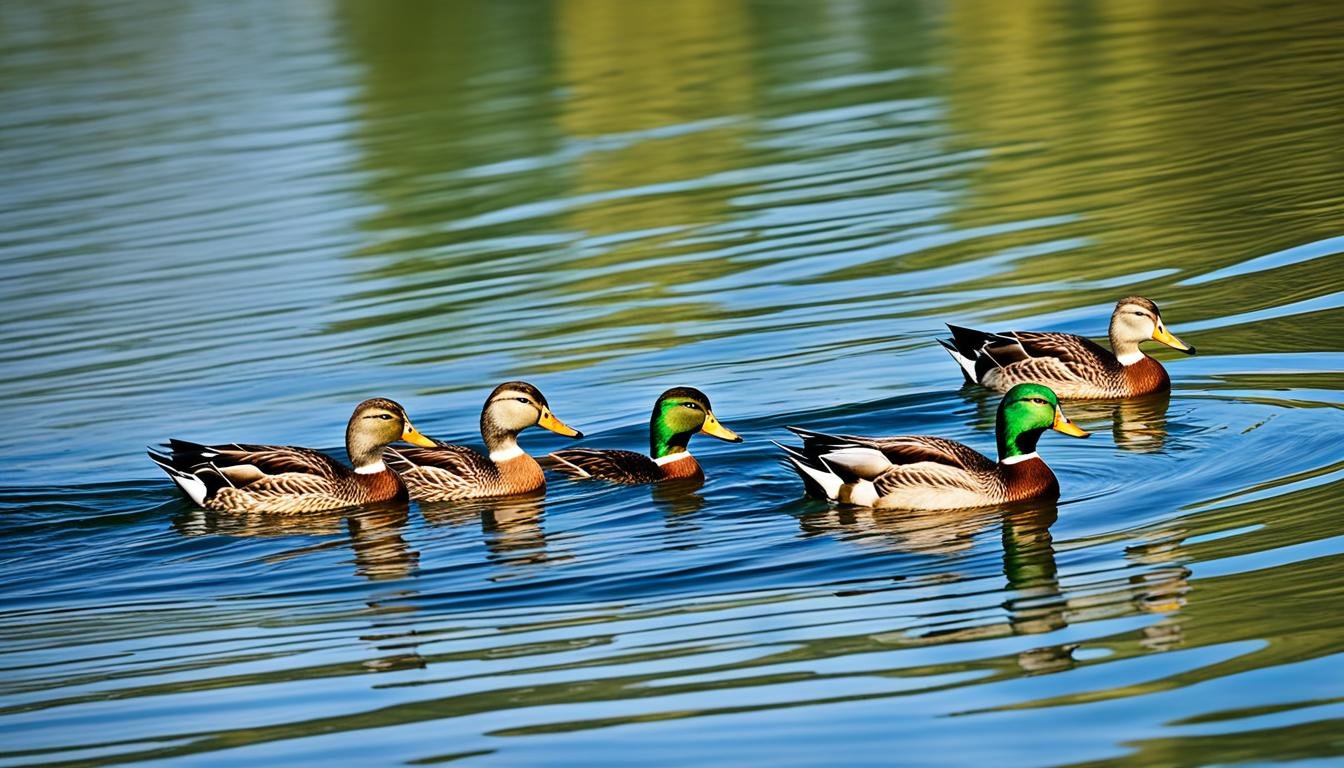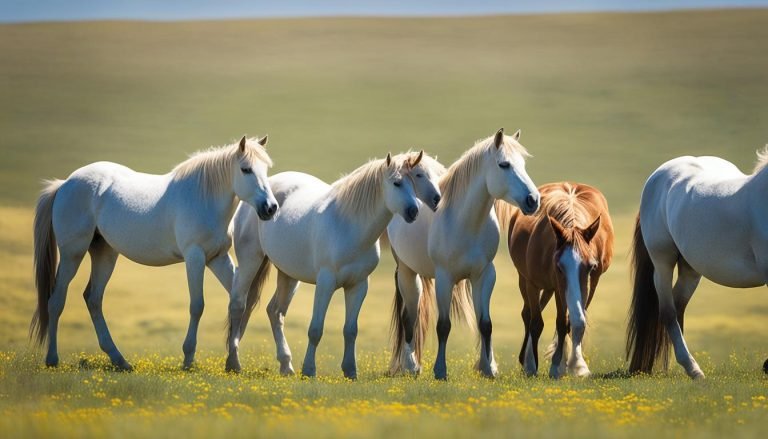Can Birds Swim? Uncovering Avian Aquatic Abilities
Have you ever marveled at a flock of ducks gracefully gliding across a pond, their feathers glistening in the sunlight? Or perhaps you’ve been captivated by the elegant movements of a flamingo as it balances effortlessly on one leg in the water. These mesmerizing scenes remind us of the incredible beauty and versatility of birds in their natural habitats.
But have you ever wondered if birds can swim? Can they navigate through water with the same ease and grace as they do through the air? The answer is both fascinating and complex, as it turns out that not all birds possess the same swimming abilities.
Join us as we dive into the intriguing world of avian aquatic abilities, exploring the adaptations that enable some bird species to swim and revealing the surprising differences between swimming and flying. From penguins and ducks to hawks and flamingos, we’ll uncover the secrets behind their swimming prowess and the unique anatomical features that support their aquatic lifestyles.
Key Takeaways:
- Not all birds can swim, and the swimming abilities of birds vary across species.
- Some bird species, like penguins and ducks, have evolved adaptations for swimming in water.
- Other bird species, like hawks and flamingos, may not be natural swimmers but can still manage short distances in the water.
- Birds have unique anatomical features that enable them to swim effectively, including streamlined bodies, specialized wings, and webbed feet.
- Exploring the swimming abilities of birds gives us a deeper understanding of the remarkable diversity and adaptability of these fascinating creatures.
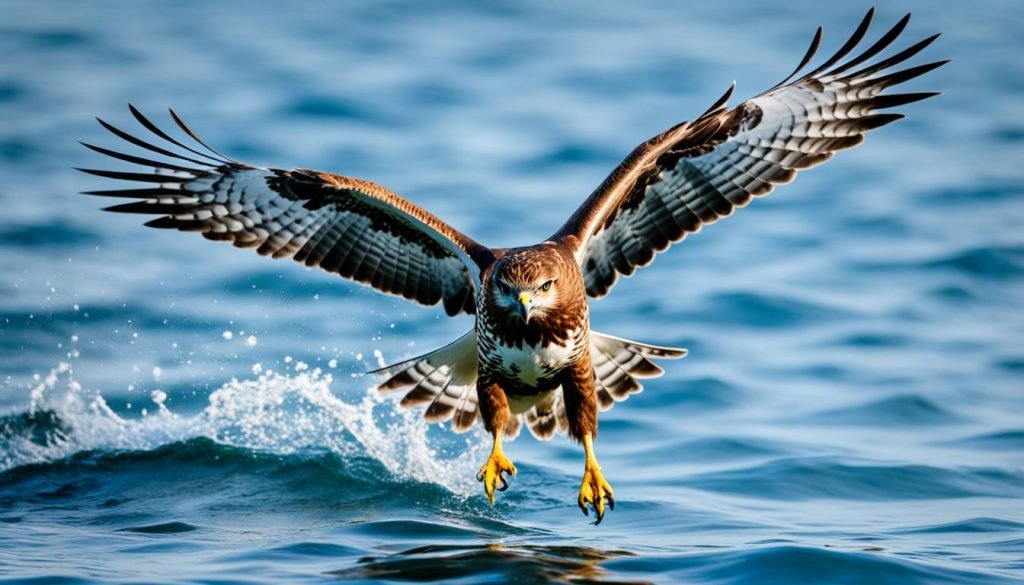
The Swimming Efficiency of Penguins
Penguins are renowned for their remarkable swimming abilities, but how efficient are they in the water? A study published in the Journal of Avian Biology set out to compare the swimming efficiency of penguins to other diving birds, specifically little penguins, and alcids like puffins and guillemots.
The researchers used mathematical models to gain insights into how the flapping wings of these birds work in the water. They sought to measure factors such as drag and propulsion to understand the swimming efficiency of each species.
The study revealed some intriguing findings. Little penguins, despite their smaller size, were not the most efficient divers in terms of dive speed and efficiency. Surprisingly, certain alcids, such as Brünnich’s guillemot, outperformed them in these measures. However, it is worth noting that despite their shallow diving distance, little penguins are still exceptional swimmers.
On the other hand, larger penguins such as emperor penguins proved to be true champions of the diving world. These majestic birds can out-dive even nuclear submarines, showcasing their impressive swimming efficiency.
| Species | Dive Speed | Dive Efficiency |
|---|---|---|
| Little Penguins | Lower than Alcids | Lower than Alcids |
| Alcids (Brünnich’s guillemot) | Higher than Little Penguins | Higher than Little Penguins |
| Emperor Penguins | Exceptional | Exceptional |
Hawks and Their Aquatic Abilities
Hawks are primarily known for their aerial hunting prowess, but they also possess swimming abilities. While not their preferred mode of locomotion, hawks can paddle and float on the water if necessary.
Observations of hawks swimming have revealed their unique adaptations for water environments. Factors such as body size, wing shape, and plumage density contribute to their swimming abilities. Larger hawks, such as the Red-tailed Hawk, have increased buoyancy, allowing them to stay afloat more easily. Wide wings and dense plumage help generate lift and minimize drag in the water, enabling hawks to navigate with relative ease.
Hawks’ swimming abilities are a testament to the incredible versatility of these avian predators. While their hunting and flying skills excel in their natural habitats, their occasional forays into water showcase their adaptability.
Though not extensively studied, these occasional observations of hawks swimming offer a glimpse into their prowess away from their aerial domain. It is fascinating to witness these majestic birds maneuver in water environments, employing a combination of wing movements and leg paddling to propel themselves. While their swimming abilities may not rival those of specialized diving birds, they demonstrate the hawk’s resourcefulness and capacity to adapt to diverse surroundings.
Hawks’ Swimming Techniques
Hawks are known for their remarkable flying and hunting abilities, but they also possess unique swimming techniques that allow them to navigate through water environments with agility and precision. These techniques include wing flapping, paddling with their feet, and diving and surfacing.
Wing flapping plays a crucial role in a hawk’s swimming technique. By rapidly flapping their wings, hawks generate lift and thrust, enabling them to stay afloat and move through the water with relative ease. This wing movement helps them maintain stability and control while swimming.
Another important aspect of a hawk’s swimming technique is paddling with their feet. Hawks use their feet as paddles, propelling themselves forward and aiding in locomotion. This paddling motion helps hawks maintain momentum and navigate through the water effectively.
In addition to wing flapping and paddling, some hawks are capable of diving and surfacing. Diving allows hawks to plunge into the water to catch prey while surfacing allows them to emerge from the water after a successful dive. These diving and surfacing techniques are crucial for hawks’ hunting strategies in aquatic environments.
The combination of wing flapping, paddling with their feet, and diving and surfacing makes hawks versatile swimmers, adapting to their surroundings as needed. These swimming techniques showcase the remarkable adaptability and agility of these magnificent birds.
Comparison of Hawks’ Swimming Techniques
| Swimming Technique | Description |
|---|---|
| Wing Flapping | Rapidly flapping wings generate lift and thrust, aiding in staying afloat and controlling movement in the water. |
| Paddling with Feet | Utilizing feet as paddles to propel forward, providing additional propulsion and improving swimming efficiency. |
| Diving and Surfacing | Plunging into the water to catch prey, followed by resurfacing to breathe and prepare for the next hunting maneuver. |
Benefits and Challenges of Swimming for Hawks
Swimming offers numerous advantages for hawks, contributing to their physical fitness and enhancing their hunting skills. The activity helps hone their wings and leg muscles, leading to increased strength and overall stamina. By swimming, hawks can practice and refine their hunting techniques in aquatic environments, improving their ability to catch prey efficiently. It allows them to adapt their hunting strategies to different conditions and develop a broader skill set in their pursuit of food.
However, swimming also presents certain challenges and risks for hawks. There is the potential for accidental entrapment in the water, which may impede their movement or hinder their ability to take flight. Additionally, larger predators lurking beneath the water’s surface pose a threat to hawks swimming in unfamiliar territories. Hawks must exercise caution to avoid becoming prey themselves.
Overall, swimming contributes to the physical fitness and hunting prowess of hawks, while also introducing new challenges that they must navigate to thrive in diverse environments.
| Benefits of Swimming for Hawks | Challenges of Swimming for Hawks |
|---|---|
|
|
Diving Birds and Their Adaptations
Diving birds, such as seabirds, waterfowl, kingfishers, and some raptors, have evolved remarkable adaptations that enable them to excel in aquatic environments. These adaptations are specifically tailored to support their diving abilities and allow them to thrive in water.
Streamlined Bodies
One of the key adaptations of diving birds is their streamlined bodies, which minimize drag as they move through the water. Their sleek and hydrodynamic shape reduces resistance, enabling them to swim swiftly and efficiently. This streamlined body structure is crucial for effective diving and hunting underwater.
Vision Adaptations
Diving birds have also developed specific vision adaptations that enhance their ability to locate prey underwater. Their eyes are adapted to see clearly in the water, allowing them to spot fish and other aquatic prey even in low-light conditions. These vision adaptations give diving birds a distinct advantage when hunting in their aquatic habitats.
Feather Waterproofing
To stay buoyant while diving, diving birds have specialized feathers that are highly waterproof. These feathers are densely packed, providing excellent insulation and preventing water from soaking through to their skin. This waterproofing ability allows diving birds to maintain their buoyancy and maneuver effectively underwater.
Leg and Foot Modifications
Diving birds possess unique leg and foot modifications that aid in their swimming and diving endeavors. Many species have webbed feet, which act as efficient paddles in the water, providing propulsion and stability. The webbing between their toes enables them to generate more power with each stroke, enabling swift swimming and diving. These leg and foot adaptations are specifically tailored to maximize their efficiency and agility in aquatic environments.
| Diving Bird Adaptations | Examples |
|---|---|
| Streamlined bodies | Common Loon, Great Cormorant |
| Vision adaptations | Osprey, Kingfisher |
| Feather waterproofing | Pelican, Grebe |
| Leg and foot modifications | Duck, Penguin |
These adaptations collectively contribute to the diving prowess of these avian species, allowing them to explore underwater habitats, find food, and thrive in aquatic ecosystems. Diving birds showcase the remarkable ability of birds to adapt and excel in diverse environments, highlighting the astonishing diversity of avian species.
Bird Species That Dive Into Water
Various bird species are known for their diving abilities. Seabirds, such as gannets, terns, and pelicans, have streamlined bodies and long wings that allow them to dive into the water with speed and accuracy. Waterfowl, including ducks, geese, and swans, are capable of diving to search for food, thanks to their specialized bills and webbed feet. Kingfishers use their sharp beaks to snatch fish out of the water, while certain raptors, like the osprey, have adapted to catch fish underwater using their powerful wings and reversible outer toes.
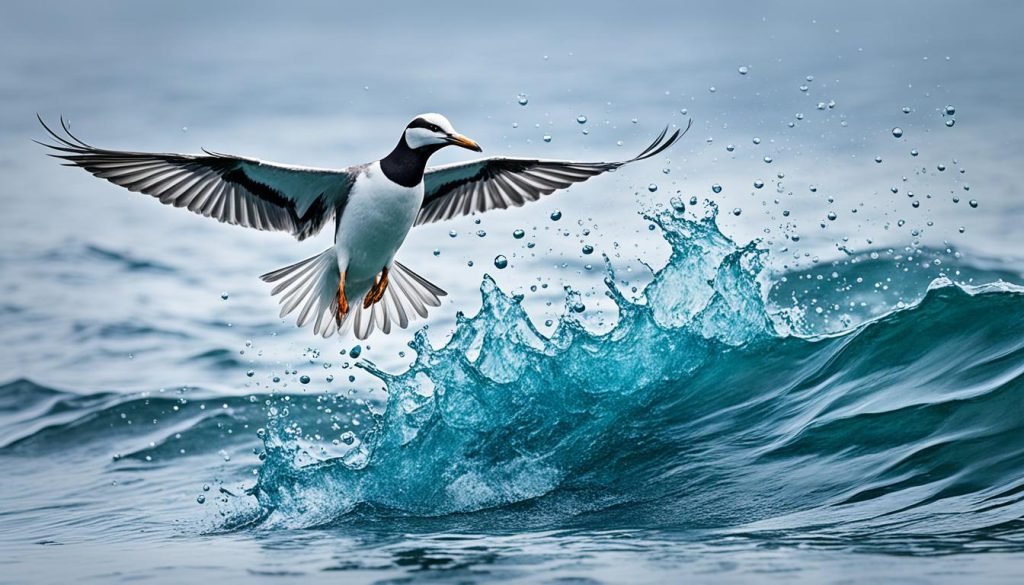
Dive Abilities of Different Bird Species
| Bird Species | Adaptations for Diving |
|---|---|
| Gannets | Streamlined bodies, long wings |
| Terns | Streamlined bodies, long wings |
| Pelicans | Streamlined bodies, long wings |
| Ducks | Specialized bills, webbed feet |
| Geese | Specialized bills, webbed feet |
| Swans | Specialized bills, webbed feet |
| Kingfishers | Sharp beaks |
| Osprey | Powerful wings, reversible outer toes |
These bird species have unique adaptations that allow them to dive into water and thrive in aquatic environments. Their diving abilities enable them to search for food and catch prey efficiently, showcasing the impressive versatility of avian species.
Adaptations That Enable Diving
Diving birds have evolved remarkable adaptations that enable them to navigate the aquatic realm with finesse. These specialized adaptations equip them to dive into water, search for prey, and thrive in their watery habitats. Let’s explore some of the key adaptations that allow diving birds to excel in their diving abilities:
Streamlined Bodies
One of the primary adaptations for diving birds is their streamlined bodies. These sleek, hydrodynamic shapes minimize drag in the water, allowing for efficient movement while swimming. The streamlined bodies reduce resistance, enabling diving birds to reach higher speeds and cover greater distances underwater.
Vision Adaptations
For hunting underwater, diving birds have developed unique vision adaptations. They possess specialized eyes that enable clear vision both above and below the water’s surface. With these adaptations, diving birds can easily locate and track prey, even in murky or turbulent underwater environments.
Feather Waterproofing
Another crucial adaptation of diving birds is their feather waterproofing. These birds have feathers with intricate structures that provide exceptional water repellency. This waterproofing keeps their plumage dry and buoyant, preventing excess water absorption and allowing them to remain afloat while swimming or diving.
Leg and Foot Modifications
Leg and foot modifications play a vital role in the diving abilities of birds. Many diving species have developed webbed feet that serve as efficient paddles, facilitating excellent propulsion and maneuverability in water. The webbing between their toes offers a greater surface area to push against the water, allowing diving birds to move swiftly and gracefully underwater.
These adaptations, along with others specific to different diving bird species, collectively enhance their ability to dive into water and thrive in aquatic environments. By finely tuning their bodies and behaviors, diving birds have evolved impressive strategies to explore underwater territories and effectively pursue their aquatic lifestyles.
Diving Techniques of Birds
Birds employ various diving techniques depending on their hunting strategies and environment.
Plunge diving, used by birds like pelicans and gannets, involves diving straight down into the water from above to catch prey.
Aerial diving, employed by birds like the osprey, involves hovering above the water and plunging feet-first to catch fish.
Pursuit diving, seen in birds like the common loon, combines swimming and diving to chase prey underwater.
Walking/floating dives, used by birds like the pied kingfisher, involve diving headfirst into the water from a perched position.
Each technique is adapted to the particular needs of the bird species.
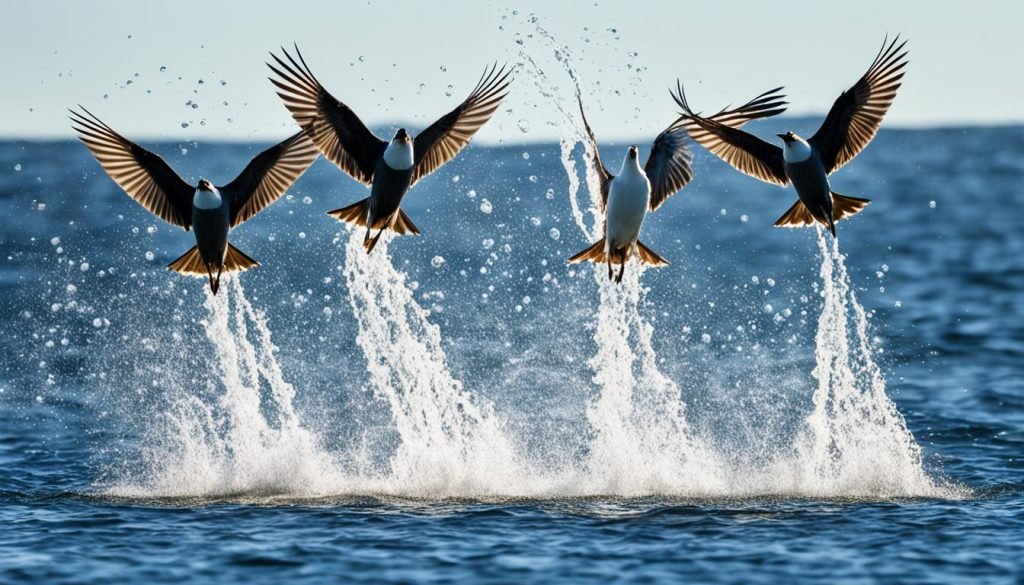
Did you know? Plunge diving is an impressive technique that allows birds to swiftly catch prey by diving straight from the air into the water.
Reasons for Diving
Birds engage in diving behavior for various reasons, each serving a specific purpose in their survival and well-being.
Foraging
One key reason for birds to dive into water is foraging. Diving allows birds to access underwater prey sources that are not readily available at the water’s surface. By submerging themselves beneath the water’s surface, birds can hunt and feed on aquatic organisms such as fish, crustaceans, and amphibians. This diving technique expands their feeding options and increases their chances of finding nourishment.
Escaping Predators
Another crucial reason for birds to dive is to escape from predators. When pursued by predators, birds can quickly submerge themselves underwater, using diving as an effective escape strategy. By concealing themselves beneath the water’s surface, birds can elude their predators and find safety in the watery depths. The ability to dive and stay submerged provides birds with a valuable defense mechanism against threats from above.
Preening
Birds may also dive into water for preening purposes. Preening is a vital aspect of a bird’s grooming routine, ensuring the maintenance of healthy feathers. Before preening, birds may wet their feathers by diving into water. Wetting the feathers helps in aligning and cleaning them, promoting proper feather function and insulation. This behavior allows birds to maintain their plumage in optimal condition, improving their overall fitness and ensuring their success in various ecological niches.
Not All Birds Can Swim
While birds are known for their ability to fly, swimming is not a skill possessed by all avian species. The swimming abilities of birds can vary significantly depending on their anatomy and adaptations.
Some bird species, such as penguins and seabirds, have evolved specialized adaptations for swimming, often at the expense of flight. These birds have streamlined bodies, webbed feet, and waterproof feathers that enable them to propel themselves efficiently through the water. Penguins, in particular, are renowned for their remarkable swimming abilities, using their wings as flippers to navigate their underwater environment.
On the other hand, there are bird species, like hawks, that are not natural swimmers. While hawks are primarily adapted for aerial pursuits and hunting, they are capable of short distances in the water. Their larger body size provides increased buoyancy, and their wings and plumage density help generate lift and minimize drag in the water.
The divergent adaptations between flight and swimming highlight the incredible diversity of avian abilities. Not all birds have evolved to be efficient swimmers, emphasizing the vast range of adaptations and specializations within the avian world.
Final Thoughts
Birds exhibit a remarkable range of swimming abilities, with some species specializing in swimming while others are more adapted for aerial pursuits. Penguins, seabirds, waterfowl, kingfishers, and certain raptors have all evolved unique adaptations to swim and hunt in water environments. These adaptations include streamlined bodies, vision adaptations, feather waterproofing, and leg and foot modifications.
Swimming provides various benefits for birds, such as improved fitness and hunting skills. It allows them to build strength in their wings and legs, enhancing overall stamina. Swimming also provides opportunities for birds to practice and refine their hunting techniques in water environments. However, swimming also presents challenges and risks, such as the potential for getting trapped in water or becoming prey for larger predators.
Understanding the swimming abilities of birds adds to our knowledge of avian physiology and highlights the remarkable diversity of these fascinating creatures. The adaptations that enable birds to swim and navigate in water environments showcase their impressive ability to adapt to different habitats. Whether gracefully gliding through the water like penguins or utilizing a combination of wing flapping and paddling like hawks, birds continue to captivate us with their aquatic abilities.
Frequently Asked Questions
Can all birds swim?
No, not all birds can swim. The ability to swim varies among bird species depending on their anatomy and adaptations.
Do birds swim in water?
Yes, some bird species are capable of swimming in water. However, swimming is not a universal ability among birds.
What are some adaptations of birds for swimming?
Birds that are adapted for swimming may have streamlined bodies, vision adaptations, feather waterproofing, and leg and foot modifications, such as webbed feet.
Can ducks swim?
Yes, ducks are known for their swimming abilities. They have webbed feet and specialized bills that enable them to swim and dive for food.
Can penguins swim?
Yes, penguins are excellent swimmers. They have evolved the ability to swim at the expense of flight and possess fin-like wings for efficient movement in the water.
Can flamingos swim?
Yes, flamingos are capable swimmers. They have long legs and webbed feet that allow them to navigate through water while foraging.
How do hawks swim?
Hawks are not natural swimmers but can paddle and float on the water’s surface if necessary. They use a combination of wing flapping and paddling with their feet to move in water.
What adaptations contribute to hawks’ swimming abilities?
Factors such as body size, wing shape, and plumage density contribute to hawks’ swimming abilities. Larger hawks have increased buoyancy, while wide wings and dense plumage help generate lift and minimize drag in the water.
What are the benefits of swimming for hawks?
Swimming provides several advantages for hawks, including improved physical fitness, development of hunting skills, and practice and refinement of hunting techniques in water environments.
What adaptations do diving birds have?
Diving birds have evolved adaptations such as streamlined bodies to minimize drag, vision adaptations for locating prey underwater, feather waterproofing to remain buoyant, and leg and foot modifications like webbed feet for efficient swimming.
What are some bird species that dive into water?
Seabirds, waterfowl, kingfishers, and certain raptors are among the bird species that have adapted to dive into water for hunting and foraging purposes.
Why do birds dive into water?
Birds dive into water for various reasons, including foraging for prey sources underwater, escaping predators by quickly submerging, and preening their feathers.
Can all birds swim?
No, not all birds can swim. The swimming abilities of birds vary depending on their anatomy and adaptations. Some bird species have evolved swimming capabilities at the expense of flight, while others are not natural swimmers.
What are the swimming abilities of birds?
Birds exhibit a range of swimming abilities, with some species specializing in swimming and others being more adapted for aerial pursuits. The swimming abilities of birds depend on their anatomy and adaptations.
Can Birds Swim conclusion
Birds have varied abilities when it comes to swimming, with some species being excellent swimmers, such as penguins and ducks, while others are not natural swimmers but possess certain swimming abilities, like hawks. Adaptations and anatomy play a crucial role in determining the swimming abilities of bird species, showcasing the remarkable diversity of avian aquatic abilities.

